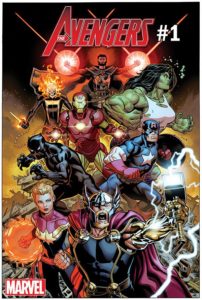 Avengers #1 — Writer: Jason Aaron; Pencils: Ed McGuinness; Inks: Mark Morales; Colors: David Curiel
Avengers #1 — Writer: Jason Aaron; Pencils: Ed McGuinness; Inks: Mark Morales; Colors: David Curiel
Weapon Lost #1 (of 4) — Writer: Charles Soule; Art: Matteo Buffagni; Colors: Jim Charalampidis
You Are Deadpool #1 (of 4) — Writer: Al Ewing; Art: Salva Espin; Colors: Guru-eFX
Avengers #1 (Marvel also includes an “LGY 691” under the “1” on the cover, meaning this is actually “legacy,” or original numbering, 691; that’s, believe it or not, important to some of us…) starts with a seven-page prologue set in one million BC, with the same ancient Avengers team that Aaron wrote about in that Marvel Legacy one-shot, and then cuts to 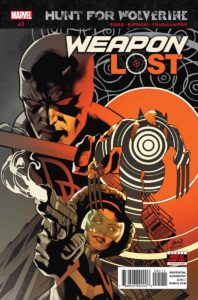 Tony Stark, Steve Rogers and Thor at a bar talking about whether to get the band back together, and not very enthusiastically… and then 2,000-foot-long dead Celestials start falling out of the sky; in between, Doctor Strange and the Black Panther investigate alien artifacts (and aliens) deep underground, and Captain Marvel, She-Hulk and the Ghost Rider get separate scenes that eventually dovetail into the main story. It’s mostly set-up, and solid enough (McGuiness isn’t head-turning, especially in the day-to-day stuff like the bar scene, but he rises to the challenge in the dramatic splash parts, and is particularly good on those one-million-BC-pages); if you’re a new or returning fan, it’s a suitably-widescreen first chapter, and a good jumping-on point, while providing regular Avengers fans more than enough reason to stick around. Weapon Lost is a “Hunt for Wolverine” tie-in mini-series, focusing on Daredevil enlisting the aid of Misty Knight, an Inhuman and a
Tony Stark, Steve Rogers and Thor at a bar talking about whether to get the band back together, and not very enthusiastically… and then 2,000-foot-long dead Celestials start falling out of the sky; in between, Doctor Strange and the Black Panther investigate alien artifacts (and aliens) deep underground, and Captain Marvel, She-Hulk and the Ghost Rider get separate scenes that eventually dovetail into the main story. It’s mostly set-up, and solid enough (McGuiness isn’t head-turning, especially in the day-to-day stuff like the bar scene, but he rises to the challenge in the dramatic splash parts, and is particularly good on those one-million-BC-pages); if you’re a new or returning fan, it’s a suitably-widescreen first chapter, and a good jumping-on point, while providing regular Avengers fans more than enough reason to stick around. Weapon Lost is a “Hunt for Wolverine” tie-in mini-series, focusing on Daredevil enlisting the aid of Misty Knight, an Inhuman and a  former New Mutant — all, in their own ways, detectives — to track down the original Canucklehead. Charles Soule is DD’s regular writer, so fans of that book should like this one too, and Buffagni gives a suitably-noirish tone to the art. You Are Deadpool is considerably more original than that — it’s a “find your own adventure” mini-series, with this first issue serving as a tutorial and a launch; based on your scores ping-ponging Wade around the pages here, you get directed to one of the three other issues of the comic coming out over the next three weeks — and then put all four together to do the whole adventure: complicated, but smart and fun, and leavened with lots of snarky humor — and definitely worth buying.
former New Mutant — all, in their own ways, detectives — to track down the original Canucklehead. Charles Soule is DD’s regular writer, so fans of that book should like this one too, and Buffagni gives a suitably-noirish tone to the art. You Are Deadpool is considerably more original than that — it’s a “find your own adventure” mini-series, with this first issue serving as a tutorial and a launch; based on your scores ping-ponging Wade around the pages here, you get directed to one of the three other issues of the comic coming out over the next three weeks — and then put all four together to do the whole adventure: complicated, but smart and fun, and leavened with lots of snarky humor — and definitely worth buying.
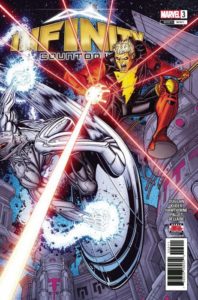 Infinity Countdown #3 (of 5) — Writer: Gerry Duggan; Pencils: Aaron Kuder and Mike Hawthorne; Inks: Aaron Kuder and Terry Pallot; Colors: Jordie Bellaire
Infinity Countdown #3 (of 5) — Writer: Gerry Duggan; Pencils: Aaron Kuder and Mike Hawthorne; Inks: Aaron Kuder and Terry Pallot; Colors: Jordie Bellaire
Captain America #701 — Writer: Mark Waid; Art: Leonardo Romero with Adam Hughes and J. G. Jones; Colors: Matthew Wilson with Adam Hughes and Paul Mounts
Rogue and Gambit #5 (of 5) — Writer: Kelly Thompson; Art: Pere Perez; Colors: Frank D’Armata
Spider-Man #240 — Writer: Brian Michael Bendis; Art: Oscar Bazaldua; Colors: Laura Martin
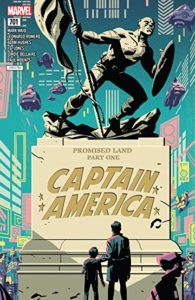 Infinity Countdown is a big chase-the-Infinity-Gems story that, duh, plays off of the Avengers movie without being part of it; the Guardians of the Galaxy and Nova Corps fight for the Power Stone, while Warlock and the Silver Surfer battle Ultron/Hank Pym for the Soul Gem. Mike Hawthorne’s version of Warlock is kind of butt-ugly, but otherwise he gets off a couple of nice effects, and Aaron Kuder’s art and coloring on the GOTG stuff makes the book, especially on at least three or four really pretty splash pages. Captain America begins a new arc (after its 700th-issue anniversary last time) with Mark Waid continuing as writer, but a new art team; Leonardo Romero does a decent job of drawing in the same neighborhood as the departed Chris Samnee, but without actually aping his style. The
Infinity Countdown is a big chase-the-Infinity-Gems story that, duh, plays off of the Avengers movie without being part of it; the Guardians of the Galaxy and Nova Corps fight for the Power Stone, while Warlock and the Silver Surfer battle Ultron/Hank Pym for the Soul Gem. Mike Hawthorne’s version of Warlock is kind of butt-ugly, but otherwise he gets off a couple of nice effects, and Aaron Kuder’s art and coloring on the GOTG stuff makes the book, especially on at least three or four really pretty splash pages. Captain America begins a new arc (after its 700th-issue anniversary last time) with Mark Waid continuing as writer, but a new art team; Leonardo Romero does a decent job of drawing in the same neighborhood as the departed Chris Samnee, but without actually aping his style. The  story’s set in the 24th century, and is about descendants of Cap: a father who seeks the still-classified super-soldier formula to help his ailing son and stumbles onto a Kree conspiracy. The 700th-anniversary story was a future-set one, too, and another one so soon feels a trifle odd, but otherwise it’s the normal entertaining job from Mark Waid, who’s been crafting good Captain America stories for a number of decades now. Rogue and Gambit is from a much newer writer, Kelly Thompson — but she’s one who, over the last few years, has established a reputation for fan-friendly stories with a lot of heart; that’s demonstrated nicely here, in the conclusion to her mini-series about the two mismatched, star-crossed mutant lovers. Get this — and the first four, which should still be on the stands too — and you’ll have an affectionate, retro-’90s reason to stay inside as the Arizona
story’s set in the 24th century, and is about descendants of Cap: a father who seeks the still-classified super-soldier formula to help his ailing son and stumbles onto a Kree conspiracy. The 700th-anniversary story was a future-set one, too, and another one so soon feels a trifle odd, but otherwise it’s the normal entertaining job from Mark Waid, who’s been crafting good Captain America stories for a number of decades now. Rogue and Gambit is from a much newer writer, Kelly Thompson — but she’s one who, over the last few years, has established a reputation for fan-friendly stories with a lot of heart; that’s demonstrated nicely here, in the conclusion to her mini-series about the two mismatched, star-crossed mutant lovers. Get this — and the first four, which should still be on the stands too — and you’ll have an affectionate, retro-’90s reason to stay inside as the Arizona 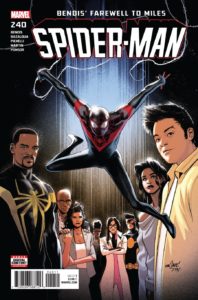 desert summer starts rolling in over the next few days. Spider-Man #240 is Brian Michael Bendis’s farewell to a title he’s been writing since 2000 (when it debuted as Ultimate Spider-Man #1); it uses a hospital stay by Miles, injured after his last adventure, to give most of the large cast their individual curtain calls, and leaves everyone in a good place for the next creators. There’s a two-page goodbye essay by Bendis at the end that’s very much worth reading, especially considering how few modern creators can boast 18-year continuous runs on a single title, no matter its name changes (let’s see: there’s Stan Sakai on Usagi Yojimbo, and Fred Perry’s Gold Digger, and Erik Larson on Savage Dragon, and…?)
desert summer starts rolling in over the next few days. Spider-Man #240 is Brian Michael Bendis’s farewell to a title he’s been writing since 2000 (when it debuted as Ultimate Spider-Man #1); it uses a hospital stay by Miles, injured after his last adventure, to give most of the large cast their individual curtain calls, and leaves everyone in a good place for the next creators. There’s a two-page goodbye essay by Bendis at the end that’s very much worth reading, especially considering how few modern creators can boast 18-year continuous runs on a single title, no matter its name changes (let’s see: there’s Stan Sakai on Usagi Yojimbo, and Fred Perry’s Gold Digger, and Erik Larson on Savage Dragon, and…?)
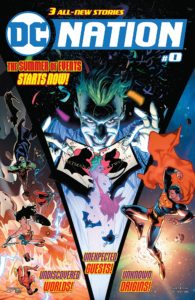 DC Nation #0 — Creators: Various
DC Nation #0 — Creators: Various
Action Comics Special #1 (of 1) — Creators: Various
Batman #46 — Writer: Tom King; Art: Tony S. Daniel; Ink Assists: Sandu Florea; Colors: Tomeu Morey
Harley Quinn: Harley Loves Joker #1 (of 2) — Writer: Paul Dini; Art: Bret Blevins; Colors: Alex Sinclair
Deathstroke #31 — Writer: Christopher Priest; Pencils: Carlo Pagulayan and Roberto Viacara; Breakdowns: Larry 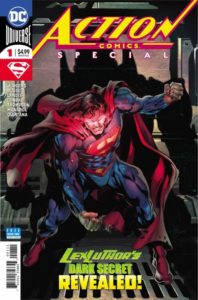 Hama; Inks: Jason Paz; Colors: jeromy Cox
Hama; Inks: Jason Paz; Colors: jeromy Cox
The Curse of Brimstone #2 — Writer: Justin Jordan; Art: Philip Tan; Colors: Rain Beredo
DC Nation #0 is a 25-cent all-new introduction to three of that company’s summer events: Tom King and Clay Mann have the Joker trying to cadge an invitation to the Bruce/Selina wedding in the Batman books; Brian Michael Bendis and the great Jose Luis Garcia-Lopez contribute a 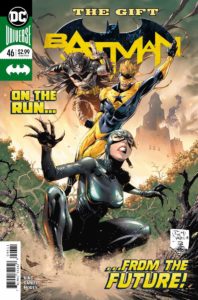 Superman tale that leads into their Man of Steel mini-series; and Scott Snyder, James Tynion IV, Joshus Williamson and Jorge Jimenez kick off Justice League: No Justice, which debuts next week. That’s a lot of top comics art and story for a quarter, so there’s no excuse not to get this. Action Comics Special gives Dan Jurgens and Will Conrad a chance to close off Jurgens’s long run on that character (think of it as Action Comics #1000.5) with a Superman/Luthor story, while Mark Russell and the wonderful Jill Thompson contribute a 10-pager, also spotlighting Lex, and Mex
Superman tale that leads into their Man of Steel mini-series; and Scott Snyder, James Tynion IV, Joshus Williamson and Jorge Jimenez kick off Justice League: No Justice, which debuts next week. That’s a lot of top comics art and story for a quarter, so there’s no excuse not to get this. Action Comics Special gives Dan Jurgens and Will Conrad a chance to close off Jurgens’s long run on that character (think of it as Action Comics #1000.5) with a Superman/Luthor story, while Mark Russell and the wonderful Jill Thompson contribute a 10-pager, also spotlighting Lex, and Mex  Bemis and Francis Manapul have an 8-pager with Lois and Clark: as the Bendis era on the title begins, this is a classy, heartfelt goodbye to the previous regime, and offers plenty of entertainment for Superman fans. Batman continues its Booster Gold time-altering story as part of the run-up to the wedding; King’s version of Booster is considerably dumber than in current continuity (maybe he’s an alternate-timeline version?), but it’s a lot of bloody fun watching him, having totally misinterpreted Bruce last issue, do the same to Selina in this one, and the Tony Daniel Catwoman stuff looks fantastic. Harley Quinn: Harley Loves Joker is a continuation/conclusion of that
Bemis and Francis Manapul have an 8-pager with Lois and Clark: as the Bendis era on the title begins, this is a classy, heartfelt goodbye to the previous regime, and offers plenty of entertainment for Superman fans. Batman continues its Booster Gold time-altering story as part of the run-up to the wedding; King’s version of Booster is considerably dumber than in current continuity (maybe he’s an alternate-timeline version?), but it’s a lot of bloody fun watching him, having totally misinterpreted Bruce last issue, do the same to Selina in this one, and the Tony Daniel Catwoman stuff looks fantastic. Harley Quinn: Harley Loves Joker is a continuation/conclusion of that  Harley back-up story that had been running in her own title; it’s from her animation-style early years, when she was still the Clown Prince of Crime’s partner, and since it’s written by her co-creator, Paul Dini, it’s worth reading — especially if you were following the earlier episodes. Deathstroke‘s often worth reading lately because of Christopher Priest (who had a big media moment earlier this year, when Black Panther director Ryan Coogler name-checked his ’90s/’00s run on the Panther’s comic as a major inspiration), who is a very good writer. If you haven’t been checking it out, the current arc is a good excuse, since it involves a big tug-of-war with Batman; since both characters are master strategists, usually six or seven moves ahead of their adversaries,
Harley back-up story that had been running in her own title; it’s from her animation-style early years, when she was still the Clown Prince of Crime’s partner, and since it’s written by her co-creator, Paul Dini, it’s worth reading — especially if you were following the earlier episodes. Deathstroke‘s often worth reading lately because of Christopher Priest (who had a big media moment earlier this year, when Black Panther director Ryan Coogler name-checked his ’90s/’00s run on the Panther’s comic as a major inspiration), who is a very good writer. If you haven’t been checking it out, the current arc is a good excuse, since it involves a big tug-of-war with Batman; since both characters are master strategists, usually six or seven moves ahead of their adversaries, 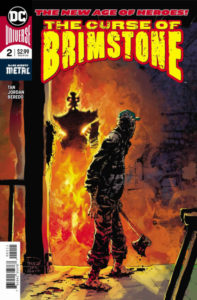 there’s a lot of clever feints and counter-feints and counter-counter feints, plus a startling maybe-reveal at the end involving another member of the Bat-cast. Curse of Brimstone, one of DC’s “New Age of Heroes” books, offers its sophomore effort about a kid in a dying town who unknowingly makes a deal with the devil (or, maybe, “a” devil) and ends up with inferno-based flame powers; the devil wants him to immolate the town, but the kid’s much-wiser sister has other ideas. This second issue was effective at deepening the background and conflicts in the first, and Philip Tan’s art (and Rain Beredo’s coloring) offer both attractive people and some nice effects on the flame stuff; this is one of the better of these new launches.
there’s a lot of clever feints and counter-feints and counter-counter feints, plus a startling maybe-reveal at the end involving another member of the Bat-cast. Curse of Brimstone, one of DC’s “New Age of Heroes” books, offers its sophomore effort about a kid in a dying town who unknowingly makes a deal with the devil (or, maybe, “a” devil) and ends up with inferno-based flame powers; the devil wants him to immolate the town, but the kid’s much-wiser sister has other ideas. This second issue was effective at deepening the background and conflicts in the first, and Philip Tan’s art (and Rain Beredo’s coloring) offer both attractive people and some nice effects on the flame stuff; this is one of the better of these new launches.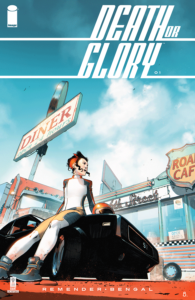
Death or Glory #1 — Writer: Rick Remender; Art/Colors: Bengal
Coda #1 — Writer: Simon Spurrier; Art: Matias Bergara; Color Assists: Michael Doig
Red Sonya/Tarzan #1 (of 6?) — Writer: Gail Simone; Art: Walter Geovani; Colors: Adriano Augusto
Death and Glory (Glory’s the name of the main character) is a noirish crime/lonesome highway/modern western mashup with fast cars, truck stops, a cash-poor protagonist whose father needs a liver transplant in a week, corrupt cops, a briefcase full of mob money, and a killer who uses liquid nitrogen and needs 123 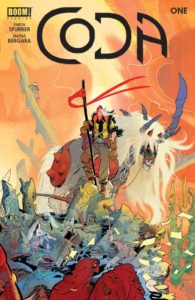 cheeseburgers (we find out why in the last panel); it’s the first new effort from Rick Remender in a while, and he’s grown noticeably: it’s cinematic and both touching and chilling in all the right places, and very efficient in sketching its world and varied characters, without a wasted panel or caption: if you like fast-paced action/adventure tales set in the scruffy byways of America — the kind of places that gave Donald Trump his presidency — it’s a particularly good one. Coda is its mirror opposite: a high-fantasy story about a world ruled by magic where, a few decades ago, that magic suddenly disappeared, leaving beings like dragons, unicorns and mermaids alive but unfueled by their former power. One small town still seems to have a good supply of it, though, and a level-headed but deadly adventurer on a quest to find his kidnapped wife gets mixed up with them —
cheeseburgers (we find out why in the last panel); it’s the first new effort from Rick Remender in a while, and he’s grown noticeably: it’s cinematic and both touching and chilling in all the right places, and very efficient in sketching its world and varied characters, without a wasted panel or caption: if you like fast-paced action/adventure tales set in the scruffy byways of America — the kind of places that gave Donald Trump his presidency — it’s a particularly good one. Coda is its mirror opposite: a high-fantasy story about a world ruled by magic where, a few decades ago, that magic suddenly disappeared, leaving beings like dragons, unicorns and mermaids alive but unfueled by their former power. One small town still seems to have a good supply of it, though, and a level-headed but deadly adventurer on a quest to find his kidnapped wife gets mixed up with them — 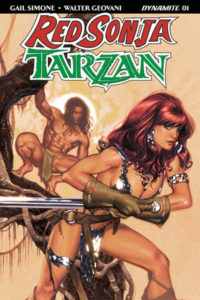 and discovers the surprising source of their wealth. Cool art and coloring by Matias Bergara (whose detailed, thin lines are reminiscent of P. Craig Russell) and Simon Spurrier’s well-thought-out and generous world-building make this stand out from the pack. Red Sonya/Tarzan benefits from Gail Simone’s ability to hit just the right character notes with her heroes while creating nasty, memorable villains; the time-traveling one here accounts for the meet-up of the two leads, as he makes enemies of them in their respective eras and they need to team up (and, presumably, hook up with other adventurers/assistants later) to stop him; get this first issue and see if you don’t want to keep reading and watch where it goes next.
and discovers the surprising source of their wealth. Cool art and coloring by Matias Bergara (whose detailed, thin lines are reminiscent of P. Craig Russell) and Simon Spurrier’s well-thought-out and generous world-building make this stand out from the pack. Red Sonya/Tarzan benefits from Gail Simone’s ability to hit just the right character notes with her heroes while creating nasty, memorable villains; the time-traveling one here accounts for the meet-up of the two leads, as he makes enemies of them in their respective eras and they need to team up (and, presumably, hook up with other adventurers/assistants later) to stop him; get this first issue and see if you don’t want to keep reading and watch where it goes next.
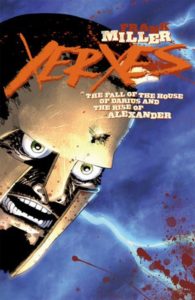 Xerxes #2 (of 5) — Writer/Artist: Frank Miller; Colors: Alex Sinclair
Xerxes #2 (of 5) — Writer/Artist: Frank Miller; Colors: Alex Sinclair
Sex Criminals #24 — Writer: Matt Fraction; Art/Colors: Chip Zdarsky
Hillbilly #9 — Creator: Eric Powell
Koshchei the Deathless #5 (of 6) — Writer: Mike Mignola; Art: Ben Stenbeck; Colors: Dave Stewart
 Stray Bullets: Sunshine and Roses #34 — Creator: David Lapham
Stray Bullets: Sunshine and Roses #34 — Creator: David Lapham
Xerxes is the second part of Frank Miller’s follow-up/prequel to 300; it focuses on the Athenians instead of the Spartans, as they defeat the Persian forces of King Darius with a combination of trickery, bravery and luck — but plant the seeds of his son Xerxes’s return later. How you feel about Miller will determine how you feel about this series: if you like his bold, impressionistic style and mix of 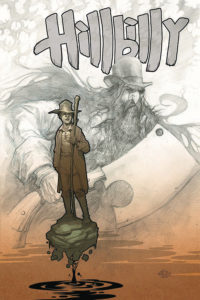 deep historical research and fantasy elements — or if you don’t know much about the ancient Greeks, and want a taste of their hardware, religion, myths and major turning points — this offers a lot of pleasure (just don’t trust Miller’s historical accuracy, because he doesn’t mind rearranging and tweaking events for dramatic effect…). Sex Criminals is starting to accelerate, as events and characters start recombining and coming together; no Suze/Jon reunion, but hey, they text each other, and it’s starting to look like
deep historical research and fantasy elements — or if you don’t know much about the ancient Greeks, and want a taste of their hardware, religion, myths and major turning points — this offers a lot of pleasure (just don’t trust Miller’s historical accuracy, because he doesn’t mind rearranging and tweaking events for dramatic effect…). Sex Criminals is starting to accelerate, as events and characters start recombining and coming together; no Suze/Jon reunion, but hey, they text each other, and it’s starting to look like 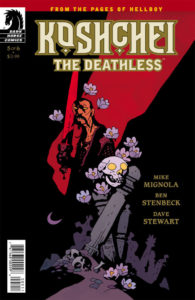 the payoff will be worth all the misery they’ve been put through the last couple of issues. Hillbilly is Eric Powell in full southern-Gothic mode, as his title character gets in big trouble, but is rescued by a long-ago acquaintance, and they team up to fight a larger evil; like Sex Criminals, it’s mostly preparing the way for even-better stuff to come later, but there’s a lot of pleasure to be had in watching Powell draw the various folk-tale creatures, swamp dwellers, witches and other supernatural denizens of his dark,
the payoff will be worth all the misery they’ve been put through the last couple of issues. Hillbilly is Eric Powell in full southern-Gothic mode, as his title character gets in big trouble, but is rescued by a long-ago acquaintance, and they team up to fight a larger evil; like Sex Criminals, it’s mostly preparing the way for even-better stuff to come later, but there’s a lot of pleasure to be had in watching Powell draw the various folk-tale creatures, swamp dwellers, witches and other supernatural denizens of his dark,  backwoods version of America. Koshchei the Deathless does something the same for the dark, Grimms’ Fairy Tales woods and moors of Europe, with Mike Mignola’s haunts and spirits and supernatural players, like Baba Yaga, brought to life by Ben Stenback, while Stray Bullets offers the usual tough-guy (and gal) noir by the always-dependable David Lapham, who’s always been very good at making each issue a self-contained story that also advances the overall plot, all meshing together seamlessly: a rare talent among current creators, and reason enough for crime fans to appreciate the comic.
backwoods version of America. Koshchei the Deathless does something the same for the dark, Grimms’ Fairy Tales woods and moors of Europe, with Mike Mignola’s haunts and spirits and supernatural players, like Baba Yaga, brought to life by Ben Stenback, while Stray Bullets offers the usual tough-guy (and gal) noir by the always-dependable David Lapham, who’s always been very good at making each issue a self-contained story that also advances the overall plot, all meshing together seamlessly: a rare talent among current creators, and reason enough for crime fans to appreciate the comic.



